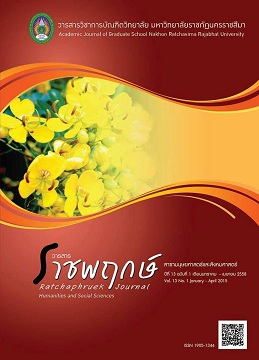The Participative Leaders’ Behavior Model Development of Students Care System Executive Education Program in School under Secondary Education Service Area Office, Zone 14
Main Article Content
Abstract
The purpose of this research was to study the participative leaders’ behavior of students care system executive education program in school under Secondary Educational Service Area Office, Zone 14 in building the model of participative leaders’ behavior development. and for evaluating and presenting the participative leaders’ behavior development model of students care system executive education program which covered the participative leaders’ behavior into3 aspects which were: 1) information sharing, 2) authority sharing, and 3) influence sharing aspects. Four phases were used for research procedure, Phase 1: Studying the participative leaders’ behavior condition of students care system executive education program in excellent and general schools, Phase 2:Developing model, and designing and building. Phase 3: Evaluating model and Phase 4:Presenting the model development. The data collecting instruments were semi-constructed interview form and a five rating scale questionnaire. The data were analyzed and summarized by frequency, percentage, mean and standard deviation.
The model was developed by three aspects, which were ONE) Information sharing aspect consisted of; 1) to support the electronic knowledge and online social changing, 2) to evaluate the latest results for considering with improving and developing in the coming year and 3) to illustrate regular and frequency public relations. TWO) Authority sharing consisted of;1) to find the chances of students to participate friendly in planning and share their opinions, suggestions and acceptations, 2) to assign the personal managing department to govern the students care system and 3) to arrange the school meeting in each grade to find out the problems and the opinions of the advisors, teachers, school grade teacher leaders and the students care system team, and THREE) Influence sharing consisted of; 1) to support in finding the experts for teachers’ training or seminar and the experts who have concerned with the students care system, 2) to support , operate and remunerate fairly, and 3) to appoint the committee seriously in considering and promoting the advisor teachers’ working who have operated their work effectively. Then, to design the model using manual building in 3 sets of developing model with 9 learning units which consist of; Set 1: Information sharing aspect was 1) the electronic knowledge learning unit, 2) data feedback for working development, and 3) public relations channel learning unit. Set 2: Authority sharing aspect was 1) participative brainstorming learning unit and teamwork development, 2) board of school administration, scope of works and duties learning unit and 3) school grade teamwork meeting. Set 3: Influence sharing aspect was 1) the suggestions of experts inviting for teachers training or seminar learning unit, 2) project and plan making for supporting learning unit, and 3) considering and promoting in students care system learning unit. There were also five important factors in developing model which were 1) principles and concepts, 2) objectives, 3) developing contents, 4) procedures and developing activities, and 5) model measuring and evaluating by the experts which showed the appropriate developing model and the excellent level of possibility.
Article Details
References
วนิดา ชนินทยุทธวงศ์. (2544). คู่มือครูที่ปรึกษาระบบการดูแลช่วยเหลือนักเรียน. พิมพ์ครั้งที่ 3. กรุงเทพฯ : โรงพิมพ์ ร.ส.พ.
วิเชียร วิทยอุดม. (2549). ภาวะผู้นำ LEADERSHIP. พิมพ์ครั้งที่ 3. กรุงเทพฯ : ธีระฟิล์ม และไซเท็กซ์.
วิเชียร วิทยอุดม. (2551). องค์การและการจัดการ Organization & Management. พิมพ์ครั้งที่ 2. กรุงเทพฯ : ธนธัชการพิมพ์.
สำนักงานคณะกรรมการการศึกษาขั้นพื้นฐาน. (2552). การดำเนินงานระบบการดูแลช่วยเหลือนักเรียนในสถานศึกษา. กรุงเทพฯ : สำนักงานคณะกรรมการการศึกษา ขั้นพื้นฐาน.
สำนักงานคณะกรรมการการศึกษาขั้นพื้นฐาน. (2552). สภาพความสำเร็จและแนวทางเสริมสร้างความเข้มแข็งระบบการดูแลช่วยเหลือนักเรียน. กรุงเทพฯ : โรงพิมพ์ชุมนุมสหกรณ์การเกษตรแห่งประเทศไทย.
Bovee, L. C. and others. (1993). Management. New York : McGraw-Hill.
Eisner, E. (1976). “Educational connoisseurship and criticism : Their form and functions in education evaluation”. The Journal of Aesthetic Education. 10(3) : 135.
House, R. J. (1971). “A path goal theory of leadership effectiveness”. Administrative Science Quarterly. 16 : 321-338.
House, R. J. (1976). “Path-goal Theory of Leadership” Journal of Contemporary Business : Autumn. 7(3) : 323-352.
Krejcie, Robert V. and Morgan W. Daryle. (1970). “Determining Sample Size for research Activities.” Educational and Psychological Measurement. 30(3) : 607-610.
McCualey, C. D. and others. (1998). The center for creative leadership handbook of leadership development. San Francisco : Jossey-Bass.


